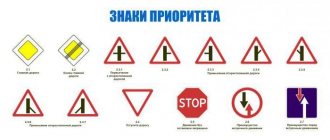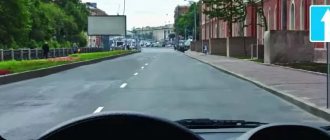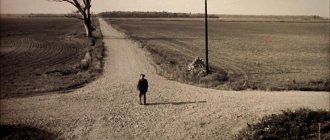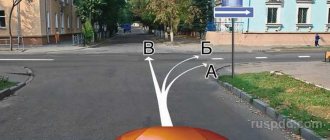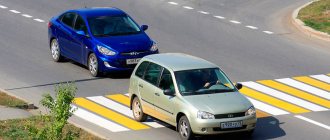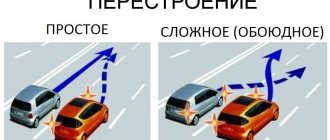2nd article of 4 in the series Priority Road Signs
Priority road signs
- Priority road signs
- Group of signs “Main Road” 2.1-2.3.7
- Priority signs “Give way” 2.4 and 2.5
- Oncoming traffic priority signs 2.6, 2.7
The first group of traffic rules priority signs are road signs related to the concept of “Main Road”.
In accordance with the definition given in paragraph 1.2 of the traffic rules, the main road is a road marked with signs 2.1, 2.3.1 - 2.3.7 or 5.1, in relation to the one being crossed (adjacent), or a road with a hard surface (asphalt and cement concrete, stone materials and the like) in relation to the dirt road, or any road in relation to exits from adjacent territories.
Since the topic of the article is priority signs, we will limit ourselves to signs 2.1, 2.2, 2.3.1 - 2.3.7. Sign 5.1 “Highway” is discussed in the article Signs of special requirements 5.1 - 5.4.
Sign 2.1 “Main Road”
Road sign 2.1 “Main Road” indicates a section of the road on which priority is given to travel through unregulated intersections.
This means that any traffic participant who approached an unregulated intersection on the main road has the right to pass through the intersection first in relation to other participants who approached this intersection on a secondary road.
In populated areas, the “Main Road” sign is installed in front of each intersection on the main road. If the intersecting road of an uncontrolled intersection has no more than four lanes, and the main road runs in a straight direction, it is allowed to install sign 2.1 of reduced size.
Intersections are formed with both the intersecting and the adjacent road (T-shaped, U-shaped).
In populated areas, before a secondary road joins the main road, it is allowed not to install the “Main Road” sign on the side opposite the junction. This means that in a populated area, before an intersection with an adjacent secondary road, sign 2.1 can be installed in front of the intersection only on the side of the road junction.
If at an intersection the main road changes its direction, as well as before intersections with a complex layout, the “Main Road” sign is used with plate 8.13 “Direction of the Main Road”. Sign 8.13 shows a schematic diagram of the intersection. The thick line symbolizes the main road, thin lines represent secondary roads.
When the main road at an intersection turns and you need to turn, you need to remember the requirement of paragraph 8.5 of the traffic rules - take a position on the roadway corresponding to the direction of the turn. For more information about the rules for turning at such intersections, see the article Exiting and turning from the main road.
If you are driving through an intersection in the forward direction, at which the main road turns right (exit onto a secondary road), you must remember the requirement of paragraph 13.10 of the traffic rules - to give way to vehicles that are turning towards you on the main road. This traffic situation is discussed in the article If the traffic light at an intersection does not work.
In populated areas, sign 2.1 with plate 8.13 is installed in front of the intersection, and outside populated areas - first at a distance of 150 - 300 meters before the intersection and in front of the intersection.
In the case where an intersection has several crossings of roadways, the “Main Road” sign is installed in front of all intersections at which there may be an ambiguous determination of the primacy of roads.
At controlled intersections, sign 2.1 “Main Road” is placed in close proximity to the main traffic light, usually on its support. A traffic light operating in the “red-yellow-green” mode cancels the priority signs.
The rules for driving through an unequal intersection, in particular, driving along the main road, including answers to some questions from readers, are set out in the Main Road series of articles.
Requirements of road sign 2.3.1
Road sign 2.3.1 encourages drivers to respect the right of way for vehicles on the main road.
The image of the intersection on the sign “Intersection with a secondary road” has significant differences in the thickness of the lines; accordingly, the thinner one is a secondary road or adjacent to the main one.
The driver, approaching an intersection with a secondary road, understands that drivers on the right or left will not interfere with traffic and will give way to the main road, regardless of the direction in which traffic on the main road occurs.
Accordingly, the driver who sees the sign's instructions will move at the permitted speed and not reduce it when approaching an intersection, except for cases when making a turn in the required direction.
However, if the offender left the secondary road without giving way, it is worth reducing the speed to prevent an accident.
Of course, the truth is on the side of the one who was driving along the main road, but a wise person simply avoids an accident, rather than a knowledgeable one, who will then prove that he is right by standing and waiting for many hours for traffic police officers.
Sign 2.2 “End of the main road”
The "End of Main Road" road sign indicates that the road on which priority has been granted for uncontrolled intersections has ended. Sign 2.2 is installed at the end of the road section where it loses its main status.
If the main road ends before an intersection, then sign 2.2 “End of the main road” is placed:
- in populated areas - either together with sign 2.4 “Give way” or 2.5 “Driving without stopping is prohibited”, or 25 meters from the intersection; a preliminary sign 2.2 with a plate 8.1.1 “Distance to object” may be installed.
- outside populated areas - on the same support with a preliminary sign 2.4 “Give way”, which is installed with a sign 8.1.1 or 8.1.2 “Distance to the object”; sign 2.2 can be re-installed with sign 2.4 or 2.5.
The secondary road does not change direction
In this case, one of the following signs must be installed in front of the intersection:
Moreover, there should not be any additional signs.
Right turn
The trajectory of the white car may intersect with the trajectory of a car that is driving towards you on a secondary road and turning left. He (the blue one) does not need to give way, and this is evidenced by paragraph 13.12 of the rules:
13.12. When turning left or making a U-turn, the driver of a trackless vehicle is obliged to give way to vehicles moving on an equivalent road from the opposite direction straight or to the right. Tram drivers should follow the same rule among themselves.
As for cars coming from all other directions (green, orange), that is, driving on the main road, they should give way.
Those. you need to give way to all cars that enter the intersection along the main road from the right and left if their trajectory intersects with yours.
Go straight
In this case, everything is exactly the same as in the previous one. You only need to give way to cars approaching the intersection along the main road (orange, green).
Turn left or make a U-turn
This situation is perhaps the most difficult at an unequal intersection. In this case, you need to give way to absolutely all cars (blue, green, orange) that are approaching the intersection. Moreover, it does not matter what maneuver each of them performs.
General rules for exiting from a secondary road to the main one
The rules for exiting from a secondary road to a main road state that the driver must assess the situation when approaching an intersection. Using an eye meter, you need to determine the distance to moving cars and their speed. Drivers on the main road have priority. Anyone entering from a secondary lane must let them through, regardless of which side they approach him from.
In wet and cloudy weather you need to be extremely careful, as distances to objects seem greater and speeds are lower.
Having stopped at an intersection, regardless of the direction of travel, the motorist must make sure that his maneuver is safe. First, the driver needs to assess the situation on the left, how far the objects are from him and how quickly they will approach. If cars are moving at high speed, then they will be at the intersection in a few seconds, and the driver simply will not have enough time to maneuver.
Main road traffic rules or the main thing you need to know about it
Almost always, the “main road” sign is installed and regulates the priority of traffic for a separate section or the entire road from the installation site to the place where the sign that terminates its effect is installed, that is, to the installed “end of the main road” sign.
It is important for the driver to correctly navigate the intersection of the main road and the secondary road and, in strict compliance with traffic rules, make a maneuver; according to the conditions of priority, the following, largely standard situations may most often arise:
We recommend reading: One-time benefits in the Arkhangelsk region for labor veterans
At the same time, the concept of “Give way (do not interfere)” is a very insidious one. Some drivers believe that they must stop when asked to give way. It is not right. If we have no one to give way to, then we shouldn’t stop.
Let's be honest, there is no such concept in the traffic rules. It is a product of the everyday language of instructors, drivers and traffic police inspectors. However, the “right hand” rule is a universal principle of traffic rules, which also concerns the problem of priority in traffic. That is why we, by our own willful decision, introduce such a concept into our presentation (do not wait for commentary on section 8 of the traffic rules).
The minor road turns right
Before the intersection, one of the following combinations must be installed:
Right turn
In this case, you need to give way to all cars approaching from the opposite direction and from the left, i.e. on the main one (blue, green).
In addition to them, the trajectory of your car can only intersect with cars that approach on the right road and make a U-turn. There is no need to give way to them, because... at the moment of intersection of the trajectories, the turning car appears to your left. This is evidenced by paragraphs 13.10 and 13.11 of the traffic rules:
13.10. In the event that the main road changes direction at an intersection, drivers moving along the main road must follow the rules for driving through intersections of equivalent roads. Drivers driving on secondary roads should follow the same rules.
13.11. At the intersection of equivalent roads, with the exception of the case provided for in paragraph 13.111 of the Rules, the driver of a trackless vehicle is obliged to give way to vehicles approaching from the right. Tram drivers should follow the same rule among themselves.
Driving straight, turning left or making a U-turn
In this case, you need to give way to absolutely all cars whose trajectories intersect with yours (orange, blue, green).
